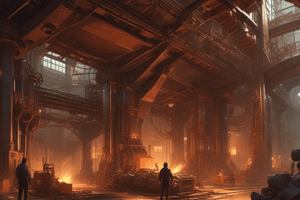Podcast
Questions and Answers
What is the carbon content range in cast iron?
What is the carbon content range in cast iron?
- 0.5% to 3%
- 3% to 5% (correct)
- 5% to 7%
- 1% to 2%
What is the approximate melting point of cast iron?
What is the approximate melting point of cast iron?
- ~1200°C (correct)
- ~1800°C
- ~1500°C
- ~900°C
Which form of cast iron is the most common?
Which form of cast iron is the most common?
- Malleable cast iron
- White cast iron
- Ductile cast iron
- Grey cast iron (correct)
What is a key advantage of cast iron in casting operations?
What is a key advantage of cast iron in casting operations?
What are the main constituents of ferrous metals?
What are the main constituents of ferrous metals?
Apart from carbon, what other element is often present in the alloy of steel and cast iron?
Apart from carbon, what other element is often present in the alloy of steel and cast iron?
What is the most common form of cast iron?
What is the most common form of cast iron?
What are the advantages of using cast iron in industry?
What are the advantages of using cast iron in industry?
What is the carbon content range in cast iron?
What is the carbon content range in cast iron?
Apart from silicon, what other elements are often added to steel and cast iron to obtain desirable properties?
Apart from silicon, what other elements are often added to steel and cast iron to obtain desirable properties?
Flashcards
What is the carbon content range in cast iron?
What is the carbon content range in cast iron?
The range of carbon content found in cast iron, typically between 2% to 4% by weight.
What is the most common form of cast iron?
What is the most common form of cast iron?
Grey cast iron is the most common form of cast iron because of its versatility and affordability.
Which form of cast iron is the most common?
Which form of cast iron is the most common?
Grey cast iron is the most common type of cast iron, known for its strength and affordability.
What is a key advantage of cast iron in casting operations?
What is a key advantage of cast iron in casting operations?
Signup and view all the flashcards
What is the approximate melting point of cast iron?
What is the approximate melting point of cast iron?
Signup and view all the flashcards
What are the main constituents of ferrous metals?
What are the main constituents of ferrous metals?
Signup and view all the flashcards
Apart from carbon, what other element is often present in the alloy of steel and cast iron?
Apart from carbon, what other element is often present in the alloy of steel and cast iron?
Signup and view all the flashcards
Apart from silicon, what other elements are often added to steel and cast iron to obtain desirable properties?
Apart from silicon, what other elements are often added to steel and cast iron to obtain desirable properties?
Signup and view all the flashcards
What are the advantages of using cast iron in industry?
What are the advantages of using cast iron in industry?
Signup and view all the flashcards
What are the advantages of cast iron in industry?
What are the advantages of cast iron in industry?
Signup and view all the flashcards
Study Notes
Carbon Content in Cast Iron
- Cast iron typically contains a carbon content range of 2% to 4%.
Melting Point of Cast Iron
- The approximate melting point of cast iron is between 1,200°C to 1,500°C.
Common Form of Cast Iron
- Grey cast iron is the most common form, recognized for its good machinability and wear resistance.
Advantages of Cast Iron in Casting Operations
- Cast iron offers excellent fluidity, making it ideal for filling intricate molds during casting processes.
Main Constituents of Ferrous Metals
- Ferrous metals primarily consist of iron, with notable elements like carbon and small additions of other alloying elements.
Presence of Other Elements in Steel and Cast Iron
- Apart from carbon, silicon is another common element present in the alloy of steel and cast iron, enhancing castability and strength.
Most Common Form of Cast Iron
- Grey cast iron is the predominant type used in a variety of applications.
Industrial Advantages of Using Cast Iron
- Cast iron is known for its durability, resistance to deformation, excellent wear resistance, and ability to absorb vibrations, making it suitable for many industrial applications.
Additional Elements for Desirable Properties
- Elements such as manganese and chromium are often added to steel and cast iron to enhance toughness, hardness, and corrosion resistance.
Studying That Suits You
Use AI to generate personalized quizzes and flashcards to suit your learning preferences.





